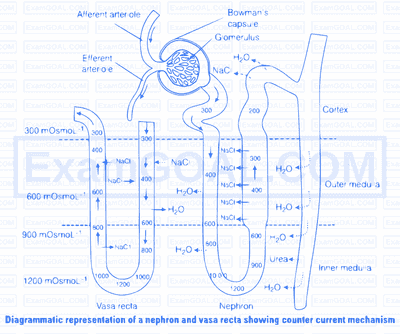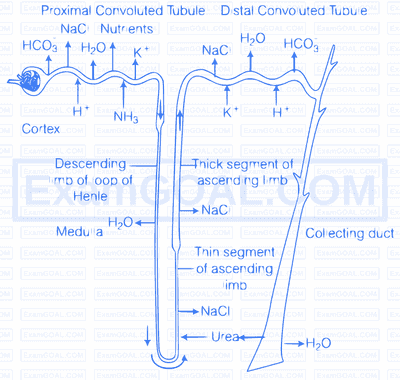Mammals have the ability to produce concentrated urine. The loop of Henle and vasa recta play a significant role in it, which can be discussed as follows
(i) The proximity between the Henle's loop and vasa recta, as well as the counter current (formed due to the flow of filtrate in two limb's of Henle's loop in opposite direction) help in maintaining an increasing osmolarity towards the inner medullary interstitium, i.e., from $300 \mathrm{mOsmoL}^{-1}$ in the cortex to about $1200 \mathrm{mOsmoL}^{-1}$ in the inner medulla.

(ii) This gradient is caused mainly due to NaCl and urea. NaCl is transported by the ascending limb of Henle's loop, which is exchanged with the descending limb of vasa recta.
(iii) NaCl is returned to the interstitium by the ascending portion of vasa recta.
(iv) Similarly, a small amount of urea enters the thin segment of the ascending limb of Henle's loop, which is transported back to the interstitium by the collecting tubule.
(v) This special arrangement of Henle's loop, and vasa recta, is called the counter current mechanism.
(vi) The counter current exchange reduces the rate of dissipation. This, inturn reduces the rate at which the current must pump $\mathrm{Na}^{+}$to maintain any given gradient.
(vii) Presence of such interstitial gradient helps in an easy passage of water from the collecting tubule thereby concentrating the filtrate (urine).
(viii) Human kidneys can produce urine nearly four times concentrated than the initial filtrate formed.
A diagram showing reabsorption and secretion of major substances at different parts of the nephron are as follows

The process of release of urine is called micturition and the neural mechanism. causing it is called the micturition reflex.
The urinary bladder and the internal sphincter are supplied by sympathetic and parasympathetic nervous systems of autonomic nervous system. In response, the stretch receptors on the walls of the bladder send signals to the Central Nervous System (CNS).
The CNS passes on motor messages to initiate the contraction of smooth muscles of the bladder and simultaneous relaxation of the urethral sphincter causing the release of urine.
Disorders of excretory system includes
(i) Uremia It is the malfunctioning of kidneys, which leads to accumulation of urea in blood in turn the kidney faliure. In such patients urea can be removed by haemodialysis.
(ii) Renal Failure (RF) It is caused by a decrease in glomerular filteration. In Acute Renal Failure (ARF) both kidneys abruptly stop working due to damaged renal tubules, kidney stones, antibiotics, etc. Haemodialysis and renal transplant are the only ways to auruve overcome renal failure.
(iii) Renal Calculi It is the formation of stones or insoluble mass of crystallised salts in the kidney.
(iv) Glomerulonephritis It is the inflammation of glomeruli of kidney.
In addition to the role of Proximal Convoluted Tublues (PCT) in selective reabsorption of materials from the glomerular filtrate back into the blood of peritubular capillaries via the renal interstitium, they also alter the composition of filtrate by the process of secretion.
In its distal part, epithelial cells extract certain excretory substances from the blood of peritubular capillaries and secrete these into the filtrate.
Creatinine, hippuric acid, pigments, drugs including penicillin are actively secreted into the filtrate in the proximal convolued tubule from the interstitial fluid. Hydrogen ions and ammonia are also secreted into the proximal convoluted tubules.
Urea enters the filtrate via diffusion in the thin segment of ascending limb of Henle's loop.
Maximum hydrogen secretion occurs in the proximal convoluted tubules. Removal of hydrogen ion and $\mathrm{NH}_3$ from the blood in the PCT and Distal Convoluted Tubule (DCT) helps in maintaining pH of the blood, i.e., between 6 to 8.
Tubular secretion although possess a minor role in functioning of the human kidney, but plays an essential role in animals like marine fishes and desert amphibians, because these animal do not possess well developed glomeruli hence their urine is mainly formed by the tubular secretion of urea, creatinine and mineral ions.
The glomerular filtrate in the loop of Henle gets concentrated in the descending loop and then gets diluted in the ascending limb. The thin wall of descending limb of Henle's loop is permeable to water, but not to the solutes. The isotonic tubular fluid flows down the limb.
It gradually looses its water the by exosmosis due to increasing osmolarity of medullary interstitium through which the limb extends.
Thus, the filtrate becomes hypertonic to blood plasma. The ascending limb of loop of Henle is impermeable to water, but permeable to ions like $\mathrm{K}^{+}, \mathrm{Cl}^{-}, \mathrm{Na}^{+}$and it is partially permeable to urea.
Thus, in the thick ascending limb of the loop of Henle, $\mathrm{Na}, \mathrm{K}, \mathrm{Ca}, \mathrm{Mg}$ and Cl are reabsorbed, making the filtrate hypotonic to blood plasma and diluted as compared to descending limb.